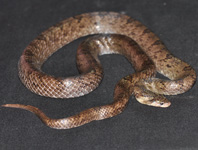Abstract
The validity of Pseudosetipinna Peng & Zhao and its type and only species, Pseudosetipinna haizhouensis Peng & Zhao, has long been doubtful due to the absence of diagnostic characters other than the lack of pelvic fins. The absence of pelvic fins in specimens of anchovies and sardines is frequently reported and usually considered a developmental malformation. We recently collected specimens of S. tenuifilis (Valenciennes) containing one specimen without pelvic fins, identifiable as P. haizhouensis. Herein, we conducted detailed morphological and genetic analyses to determine the validity of P. haizhouensis. The morphological results confirmed that the absence of pelvic fins allows the distinction between P. haizhouensis and S. tenuifilis. The genetic results showed that the mitochondrial haplotype of P. haizhouensis is shared with S. tenuifilis. Altogether, the evidence suggests that P. haizhouensis and S. tenuifilis belong to the same species. Consequently, Pseudosetipinna is a junior synonym of Setipinna Swainson and P. haizhouensis is a junior synonym of S. tenuifilis.
References
Bloom, D.D. & Lovejoy, N.R. (2014) The evolutionary origins of diadromy inferred from a time-calibrated phylogeny for Clupeiformes (herring and allies). Proceedings of the Royal Society B: Biological Sciences, 281, 2013–2081.
https://doi.org/10.1098/rspb.2013.2081Dawson, C.E. (1964) A bibliography of anomalies of fishes. Gulf Research Reports, 1, 308–399.
https://doi.org/10.18785/grr.0106.01Dawson, C.E. (1966) A bibliography of anomalies of fishes. Supplement 1. Gulf Research Reports, 2, 169–176.
https://doi.org/10.18785/grr.0202.03Dawson, C.E. (1971) A bibliography of anomalies of fishes. Supplement 2. Gulf Research Reports, 3, 215–239.
https://doi.org/10.18785/grr.0302.05Dawson, C.E. & Heal, E. (1976) A bibliography of anomalies of fishes. Supplement 3. Gulf Research Reports, 5, 35–41.
https://doi.org/10.18785/grr.0502.05Eschmeyer, W.N., Fricke, R. & van der Laan, R. (2017) Catalog of Fishes electronic version (January 2017). Available from: http://research.calacademy.org/ichthyology/catalog/fishcatmain.asp (accessed 28 June 2017)
Hettler, W.F. (1971) A yellowfin menhaden without pelvic fins. Quarterly Journal of The Florida Academy of Sciences, 34, 63–66.
Hussain, S.M. (1979) Record of a clupeoid fish Nematalosa nasus without an anal fin. Hydrobiologia, 63, 185–188.
https://doi.org/10.1007/BF00030082Kottelat, M. (2013) The fishes of the inland waters of Southeast Asia: a catalogue and core bibliography of the fishes known to occur in freshwaters, mangroves and estuaries. The Raffles Bulletin of Zoology, 27 (Supplement), 1–663.
Lavoué, S., Miya, M., Musikasinthorn, P., Chen, W.-J. & Nishida, M. (2013) Mitogenomic Evidence for an Indo-West Pacific origin of the Clupeoidei (Teleostei: Clupeiformes). PLoS ONE, 8, e56485.
https://doi.org/10.1371/journal.pone.0056485Marr, J.C. (1945) A specimen of Engraulis mordax Girard, lacking ventral fin. Copeia, 1945, 115.
https://doi.org/10.2307/1437518Menezes, N.A. & de Pinna, M.C.C. (2000) A new species of Pristigaster, with comments on the genus and redescription of P. cayana (Teleostei: Clupeomorpha: Pristigasteridae). Proceedings of the Biological Society of Washington, 113, 238–248.
Nair, P.N.R. (1973) On an abnormal specimen of rainbow sardine Dussumieria hasselti without ventral fins. Journal of the Marine Biological Association of India, 15, 885–886.
Parimala, S. (1983) Estuarine gizzard shad Nematalosa nasus (Bloch) without pelvic fins. Indian Journal of Fisheries, 30, 167–169.
Peng, Y.B. & Zhao, Z.R. (1988) A new genus and a new species of Chinese anchovies. Journal of Fisheries of China, 12, 355–358.
Shah, T.H., Chakraborty, S.K., Jaiswar, A.K., Deshmukhe, G. & Mohite, A.S. (2011) Record of an oil sardine Sardinella longiceps Valenciennes 1847 without pelvic fins. Journal of Fisheries International, 6, 59–61.
Silvestro, D. & Michalak, I. (2012) raxmlGUI: a graphical front-end for RAxML. Organisms Diversity & Evolution, 12, 335–337.
https://doi.org/10.1007/s13127-011-0056-0Stamatakis, A. (2006) RAxML-VI-HPC: maximum likelihood-based phylogenetic analyses with thousands of taxa and mixed models. Bioinformatics, 22, 2688–2690.
https://doi.org/10.1093/bioinformatics/btl446Whitehead, P.J.P., Nelson, G.J. & Wongratana, T. (1988) Clupeoid fishes of the World (Suborder Clupeoidei): An annotated and illustrated catalogue of the herrings, sardines, pilchards, sprats, shads, anchovies and wolf herrings. Part 2. Engraulididae. FAO Fisheries Synopsis, 125, 305–579.
Wongratana, T. (1983) Diagnoses of 24 new species and proposal of a new name for a species of Indo-Pacific clupeoid fishes. Japanese Journal of Ichthyology, 29, 385–407.
Yamanoue, Y., Setiamarga, D.H.E. & Matsuura, K. (2010) Pelvic fins in teleosts: structure, function and evolution. Journal of Fish Biology, 77, 1173–1208.
https://doi.org/10.1111/j.1095-8649.2010.02674.xYoung, S.S., Chiu, T.S. & Shen, S.C. (1994) A Revision of the Family Engraulidae (Pisces) from Taiwan. Zoological Studies, 33, 217–227.
Zhang, C.G., Musikasinthorn, P. & Watanabe, K. (2002) Channa nox, a new channid fish lacking a pelvic fin from Guangxi, China. Ichthyological Research, 49, 140–146.

